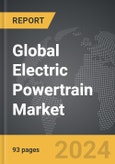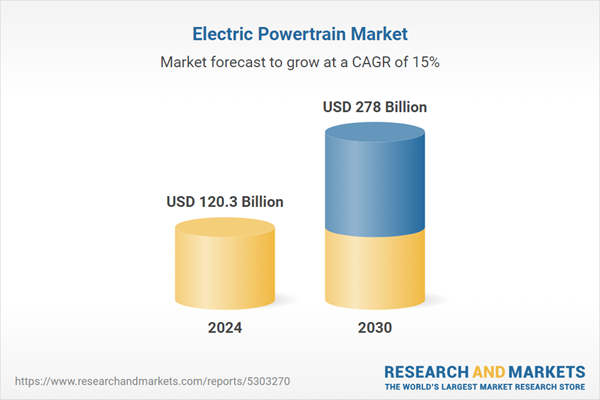Global Electric Powertrain Market - Key Trends & Drivers Summarized
Why Are Electric Powertrains Integral to the Future of Transportation?
Electric powertrains are central to the transition toward sustainable transportation, providing a cleaner, quieter, and more efficient alternative to traditional internal combustion engine (ICE) powertrains. Comprising components such as electric motors, batteries, controllers, and regenerative braking systems, electric powertrains are fundamental to the operation of electric vehicles (EVs) and hybrid vehicles. As countries implement stricter emissions regulations and consumers prioritize eco-friendly transportation, the demand for electric powertrains is on the rise. Electric powertrains eliminate tailpipe emissions, contributing significantly to reducing urban air pollution and greenhouse gas emissions. Additionally, the lower operating costs of electric powertrains, due to fewer moving parts and reduced fuel requirements, make them attractive to both consumers and fleet operators, further accelerating their adoption.Electric powertrains offer several advantages over ICE powertrains, including instant torque delivery, which enhances vehicle performance and acceleration. This responsiveness makes electric powertrains especially appealing in the high-performance EV market, where quick acceleration and seamless driving experience are key selling points. As battery technology improves, electric powertrains are also enabling greater driving ranges and shorter charging times, addressing two of the main concerns consumers have regarding EV adoption. Together, these factors are positioning electric powertrains as the future of personal and commercial transportation, supporting the shift toward electrification and decarbonization.
What Technological Innovations Are Driving the Electric Powertrain Market?
The electric powertrain market is experiencing rapid advancements in technology, particularly in battery energy density, motor efficiency, and thermal management systems. Improvements in lithium-ion and solid-state battery technologies are enabling higher energy density and faster charging, allowing electric vehicles to achieve longer ranges with less downtime. Solid-state batteries, for example, offer a safer and more efficient alternative to traditional lithium-ion batteries, potentially reducing the weight and space required for energy storage. This technological progress is critical for expanding the feasibility of electric powertrains, particularly in commercial applications where range and reliability are essential.Furthermore, innovations in electric motor design, such as permanent magnet synchronous motors and induction motors, are improving efficiency and performance while minimizing energy loss. Regenerative braking systems, which capture and store energy lost during braking, are another significant advancement in electric powertrains, helping to extend driving range and reduce battery degradation. Thermal management systems are also being optimized to prevent overheating in powertrain components, especially under high-performance conditions, thus enhancing the safety and longevity of electric vehicles. These technological advancements are making electric powertrains more efficient, accessible, and reliable, fueling the growth of the EV market and promoting further adoption of sustainable transportation solutions.
What Are the Main Applications of Electric Powertrains?
Electric powertrains are primarily used in electric vehicles (EVs) and hybrid electric vehicles (HEVs), where they replace or supplement traditional internal combustion engines. In the passenger vehicle segment, electric powertrains provide a quiet, efficient, and low-maintenance alternative to conventional powertrains, appealing to consumers who prioritize environmental sustainability and long-term savings on fuel costs. The commercial transportation sector is also increasingly adopting electric powertrains, particularly for buses, delivery vans, and trucks. These applications benefit from the cost savings associated with electric powertrains, as they require less maintenance and operate at a lower cost per mile compared to diesel-powered alternatives.In addition to on-road vehicles, electric powertrains are also being integrated into off-road and recreational vehicles, including construction machinery and electric boats, where they offer high torque and low emissions. As industries continue to prioritize sustainable practices, electric powertrains are being adopted in diverse applications beyond traditional vehicles, further underscoring their versatility and importance in reducing emissions across sectors.
What Is Driving Growth in the Electric Powertrain Market?
The growth in the electric powertrain market is driven by several factors, including regulatory incentives for emissions reduction, consumer demand for eco-friendly vehicles, and advancements in electric vehicle technology. Governments worldwide are introducing policies and subsidies to encourage the adoption of EVs, making electric powertrains more financially accessible to consumers and manufacturers. Rising environmental awareness is also contributing to market growth, as consumers prioritize sustainable transportation options that minimize their carbon footprint. This shift in consumer preferences is driving automakers to expand their EV offerings, further boosting the demand for electric powertrain components.Technological advancements, such as improvements in battery technology, regenerative braking, and electric motor efficiency, are enhancing the performance and appeal of electric powertrains. Additionally, the growth of EV charging infrastructure, supported by both government and private investments, is making electric vehicles more practical for daily use. Together, these factors are supporting the widespread adoption of electric powertrains, positioning them as the cornerstone of the shift toward sustainable and efficient transportation.
Report Scope
The report analyzes the Electric Powertrain market, presented in terms of market value (US$ Thousand). The analysis covers the key segments and geographic regions outlined below.- Segments: Component (Battery, Power Electronics Controller, Motor / Generator, Transmission, Other Components); Electric Vehicle (BEV, HEV / PHEV).
- Geographic Regions/Countries:World; United States; Canada; Japan; China; Europe (France; Germany; Italy; United Kingdom; and Rest of Europe); Asia-Pacific; Rest of World.
Key Insights:
- Market Growth: Understand the significant growth trajectory of the Battery Component segment, which is expected to reach US$171.9 Billion by 2030 with a CAGR of a 14.4%. The Power Electronics Controller Component segment is also set to grow at 16.7% CAGR over the analysis period.
- Regional Analysis: Gain insights into the U.S. market, valued at $32.5 Billion in 2024, and China, forecasted to grow at an impressive 13.8% CAGR to reach $41.7 Billion by 2030. Discover growth trends in other key regions, including Japan, Canada, Germany, and the Asia-Pacific.
Why You Should Buy This Report:
- Detailed Market Analysis: Access a thorough analysis of the Global Electric Powertrain Market, covering all major geographic regions and market segments.
- Competitive Insights: Get an overview of the competitive landscape, including the market presence of major players across different geographies.
- Future Trends and Drivers: Understand the key trends and drivers shaping the future of the Global Electric Powertrain Market.
- Actionable Insights: Benefit from actionable insights that can help you identify new revenue opportunities and make strategic business decisions.
Key Questions Answered:
- How is the Global Electric Powertrain Market expected to evolve by 2030?
- What are the main drivers and restraints affecting the market?
- Which market segments will grow the most over the forecast period?
- How will market shares for different regions and segments change by 2030?
- Who are the leading players in the market, and what are their prospects?
Report Features:
- Comprehensive Market Data: Independent analysis of annual sales and market forecasts in US$ Million from 2024 to 2030.
- In-Depth Regional Analysis: Detailed insights into key markets, including the U.S., China, Japan, Canada, Europe, Asia-Pacific, Latin America, Middle East, and Africa.
- Company Profiles: Coverage of players such as Borgwarner, Bosch, Brusa Electronik, CC Power Electronics, Continental AG and more.
- Complimentary Updates: Receive free report updates for one year to keep you informed of the latest market developments.
Some of the 42 companies featured in this Electric Powertrain market report include:
- Borgwarner
- Bosch
- Brusa Electronik
- CC Power Electronics
- Continental AG
- Curtis Instruments
- Dana Incorporated
- Denso
- Filtran LLC
- Hitachi
- Kelly Controls
- Magna
- Magneti Marelli Ck Holdings
- Mitsubishi Electric
- Moura Batteries
- Nidec Corporation
- Panasonic
- Toyota Industries Corporation
- Valeo Group
- ZF
This edition integrates the latest global trade and economic shifts into comprehensive market analysis. Key updates include:
- Tariff and Trade Impact: Insights into global tariff negotiations across 180+ countries, with analysis of supply chain turbulence, sourcing disruptions, and geographic realignment. Special focus on 2025 as a pivotal year for trade tensions, including updated perspectives on the Trump-era tariffs.
- Adjusted Forecasts and Analytics: Revised global and regional market forecasts through 2030, incorporating tariff effects, economic uncertainty, and structural changes in globalization. Includes historical analysis from 2015 to 2023.
- Strategic Market Dynamics: Evaluation of revised market prospects, regional outlooks, and key economic indicators such as population and urbanization trends.
- Innovation & Technology Trends: Latest developments in product and process innovation, emerging technologies, and key industry drivers shaping the competitive landscape.
- Competitive Intelligence: Updated global market share estimates for 2025, competitive positioning of major players (Strong/Active/Niche/Trivial), and refined focus on leading global brands and core players.
- Expert Insight & Commentary: Strategic analysis from economists, trade experts, and domain specialists to contextualize market shifts and identify emerging opportunities.
Table of Contents
Companies Mentioned (Partial List)
A selection of companies mentioned in this report includes, but is not limited to:
- Borgwarner
- Bosch
- Brusa Electronik
- CC Power Electronics
- Continental AG
- Curtis Instruments
- Dana Incorporated
- Denso
- Filtran LLC
- Hitachi
- Kelly Controls
- Magna
- Magneti Marelli Ck Holdings
- Mitsubishi Electric
- Moura Batteries
- Nidec Corporation
- Panasonic
- Toyota Industries Corporation
- Valeo Group
- ZF
Table Information
| Report Attribute | Details |
|---|---|
| No. of Pages | 180 |
| Published | January 2026 |
| Forecast Period | 2024 - 2030 |
| Estimated Market Value ( USD | $ 120.3 Billion |
| Forecasted Market Value ( USD | $ 278 Billion |
| Compound Annual Growth Rate | 15.0% |
| Regions Covered | Global |









